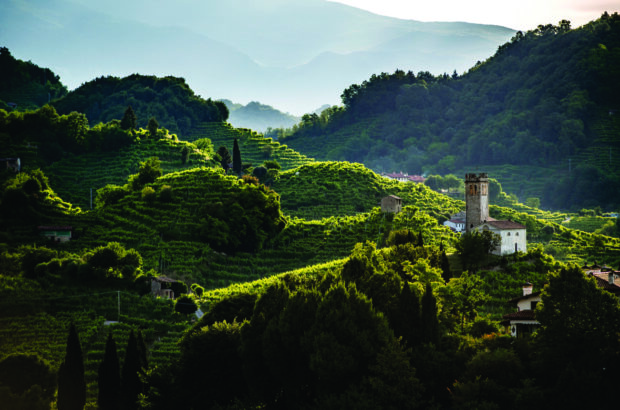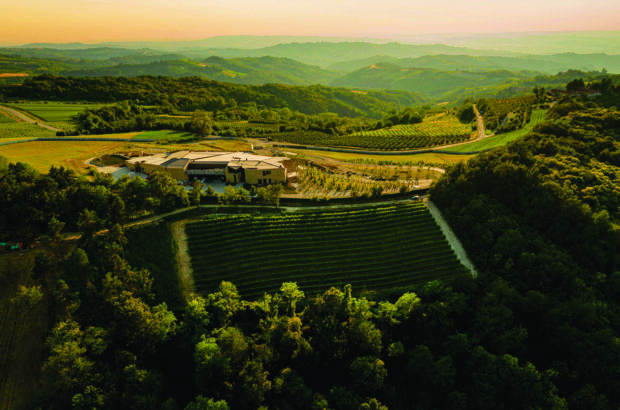The brown bears of the Balkans and the wines of northern Greece have both benefited from the energy, vision and passion of Yiannis Boutaris. In 1993, Boutaris founded Arkturos, a sanctuary dedicated to the conservation of the brown bear. The reserve now houses 13 bears and 21 wolves and, as a result, Greece has one of the most important bear populations in Europe. His boost to the wines of his country has been equally welcome, and necessary. Viewed by many as leader of the Greek wine industry, Boutaris split from his brother – and the huge Boutari corporation – in 1996 and set up a new venture with his son Mihalis, who studied at Davis and is tipped by many to be the great new hope for Greek wine. The wines resulting from their efforts, produced under the umbrella of The General Wine Company, are a good illustration of the quality, energy and confidence that can be found now in wineries across the mountainous region. ‘We’ve got the climate and the winemakers; now we just need the markets,’ says Yiannis.
Like many other producers, Boutaris recognises that the Greekness of the wines is both a help and a hindrance. Limited production and the absence of mechanical harvesting mean that these wines will never compete on price with the wines of the New World, and must sell themselves by their unusual indigenous grape varieties. But the image of Greek wine abroad means that the industry must first establish its quality credentials with its interpretations of the familiar international grapes. ‘We want to sell good wine that just happens to be Greek. The Greekness shouldn’t be the identifier,’ he continues. ‘We use the international grapes as passports, but these should be there primarily to complement our native grapes.’
He is frustrated by the entrenched cynicism with which the wines of his country are usually approached. ‘Bad Italian wine is considered better than a good Greek wine. We call it the retsina stigma, and I don’t know if this will ever pass.’ Try the wines produced by the rising stars of this mountainous region, and it’s hard to imagine that these producers will have much difficulty in getting the message across. There’s still a great deal of bad wine made in Macedonia, make no mistake, but the good is very good indeed. This was clear to Oddbins buyer Steve Daniel when he visited the region three years ago and scooped the cream; the high-street chain now has one of the strongest Greek portfolios in the UK, with some 40 wines, and Daniel is a fervent believer that the wines are getting better every year.
‘These wines offer consumers something different; they’re like French or Italian wine, but with more fruit and warmth. We’re not expecting them to take on Chile or Argentina – most of the producers are boutique wineries and aren’t going for the mass market. They don’t want to take on the world, simply to get a presence and to show the world that Greek wine can be excellent. The best
producers have a buoyant domestic market and could sell everything at home easily, but they want international recognition.’The efforts of Yiannis and Mihalis Boutaris mean that the winemaking region of Macedonia is very much the centre of attention. Some 500 miles north of Athens, the Balkan influence is marked up here – the former Yugoslav republic of Macedonia lies just over the mountains. With a continental climate and frequent rainfall, this northerly area has extreme heat in the summer and often bitterly cold winters.
Piedmont of Greece
The grapes that fare best in this harsh climate produce wines with crisp acidity. The main focus is on red wine, usually made from the Xinomavro grape. To earn an appellation in the mainly red producing region of Naoussa, the wine must be 100% Xinomavro; to the east in Goumenissa, this can be softened with Negoska, which lowers Xinomavro’s natural tannins and acidity when vinified together. Xinomavro is a wine lover’s wine, rather than an easy drinking crowd pleaser. With a low colour and flavours of game and sun-dried tomatoes, the grape is often compared with Nebbiolo in its youth, largely due to the high tannin and acidity. The wine improves with barrel ageing, and has the potential to age for between five and twelve years – with time, it takes on a more Burgundian character, with Pinot Noir soft fruit flavours. Red wines generally work better than the rosés made from Xinomavro.’Macedonia is the Piedmont of Greece,’ says Daniel. ‘It’s even similar scenically. We’re seeing a stylistic change now as the best producers get to grips with Xinomavro and learn how to soften it slightly and get the grapes ripe without losing the character. Don’t forget that it’s only in the 1990s that the Piedmontese grasped how to harness and tame Barbaresco and Barolo.’ White wines of note are also emerging from the region, sometimes from Chardonnay but usually from aromatic grape varieties – these work best, adding intense flavours to the streak of acidity always present. Alongside international grapes such as Sauvignon Blanc and Gewurztraminer, the native grape Roditis is widely grown. This is the grape of retsina when grown elsewhere in Greece, on the plains. When grown at altitude in Macedonia, however, Roditis really comes into its own and the resulting wines display concentrated aromatic, fruity flavours.
The big boys
Though most producers in the region are small, with limited production, there are a handful of large companies dominating the landscape. Kostas Lazaridis is one of only two Greek wineries to be publicly listed, and produces the most expensive Greek wine on sale in the UK. Amethystos Cava costs £15 and yet is classified as a table wine under Greek wine law since it is made from Cabernet Sauvignon. With only around 10,000 bottles produced annually, the wine is made from old vines, aged in oak for 18 months and then in bottle for two years. The 1997 vintage, just released, is delicious (see above). The other listed company, and former home of Yiannis, is Boutaris, founded in 1879. With wineries across Greece, this mammoth operation bottles many of its wines at its Stenimachos premises. The wines, varietally labelled, are easy drinking, mostly unexciting and aimed at the mass market. The best are the whites made from aromatic varieties.
Equally large is Tsantalis, a huge, high-profile négociant which led the Greek market for 10 years before deciding to buy vineyards and start growing grapes itself. It now controls about 1,500ha in northern Greece, and owns around 200ha. Though volume driven, the wines Tsantalis produces are of a high standard and represent good value for money. The range focuses on native grapes and includes a new-wave retsina.
Smaller in size
Much smaller in size is The General Wine Company, the company formed by Yiannis and Mihalis Boutaris. The father and son produce outstanding wines at two wineries in northern Greece – reds at Kyr-Yianni and whites at Vergoritis. The 28ha planted at Kyr-Yianni is mostly Xinomavro, with a little Merlot and Syrah. The Merlot is used to give the Xinomavro a more ‘feminine’ side, in the words of Mihalis. The wine is aged in barrel for 12–24 months. ‘We also bottle age the wine for six to 12 months,’ he says, ‘as the Greeks aren’t ready to buy to lay down.’ Further east, beside the vast expanse of water that is Lake Vergoritis, a PortaKabin stands as HQ at the father and son’s latest venture. ‘Good materials and equipment are more important than a glamorous winery,’ shrugs Yiannis. ‘I hate glamorous wineries.’
This cold part of the region lies at 700m altitude and has sandy, silt soil. Yiannis Boutaris explains that they are looking for an expression of terroir, and typically, here, this means spicy. Traditionally a red wine area, the Boutaris have introduced Roditis, Chardonnay, Sauvignon and Gewurztraminer. The wines being produced here are excellent.
Another small producer making waves in Macedonia is Gerovassilou, based near Thessaloniki airport. Production is limited here as plantings amount to 30ha and no grapes are bought in. The yields are very low for Greece at just 40 hectolitres per hectare (rather than the usual 60–80). Too warm here for Xinomavro, the reds are made from Syrah and Merlot. The whites are excellent, with an emphasis on Malagousia. A 100% Viognier barrel sample also showed huge promise.
Rare commodity
As you’d expect in a region of mostly small producers, there are many excellent wines being made that are nearly impossible to get hold of. One such wine is Chisohoou’s 1998 Special Cuvée, one of the best Xinomavro and Merlot blends made in northern Greece; but only 7,000 bottles are produced annually and Germany is the only export market. Another excellent winery is Aidarinis in Goumenissa. The vineyards are just 5ha, and the winery sells 80% of its wine unbottled. What it does bottle, though, is extremely good, both the red (Xinomavro and Negoska) and Roditis/Sauvignon Blanc blend. None of the 30,000 bottles produced annually are yet exported. If you’re ever in Macedonia…
Xinomavro (red)
2000 Tsantalis Xinomavro
Fresh, appealing style – a good beginner’s Xinomavro. Red fruit and slightly leathery flavours. Fairly sweet tannins, well balanced with acidity. Lean. N/A UK
2000 Boutari Moschofilero
Very pale. Lean, green, grapefruity and melon aromas; slightly perfumed. Aromatic, fresh with bold lemon flavours. Good length.
2000 Kostas Lazaridis, Chateau Julia Assyrtiko
Pale gold, with a peachy hue. Rich, spicy nose. Rich palate with a silky mouthfeel. Spice and apple on palate; dry with lively acidity. £6.45
2000 Tsantalis Athiri
A pale unoaked wine, almost clear. Light, crisp fruity aromas of apples, slight lemon, with a floral edge. Crisp and tangy with good acidity. Fresh and fragrant. N/A UK
2000 Vergoritis Grypas Samaropetra
75% oak-aged Roditis, with Gewurz and Sauvignon making up the rest. Elegant and fragrant nose. Rose petals and spice follow to palate, which also has broader spicy, fat notes. Lively acidity and zingy crispness. N/A UK
1997 Kostas Lazaridis Amethystos Cava
Dark, almost inky, ruby to purple colour with a nose of big, minty ripe black fruit and coffee. Full bodied and juicy, with a smokey flavour, sweetish but firm tannins, and spice. £14.99
1997 Tsantalis Metoxi
Jammy, leathery black fruit on the nose, with a touch of cedar. Soft and elegant on the palate, with black cherry bitterness. 75% Cabernet Sauvignon and 25% Limnio. £7.49
1997 Kyr-Yianni Syrah
Complex, delicate fruity nose. Good balance of fruit and spice on the palate, with a real bite to it. £8.99
1999 babatzim merlot
Deep ruby-purple. Very ripe black fruit and vanilla nose. Fruity and well structured, with a herby, long finish. Excellent Merlot. £8 approx












